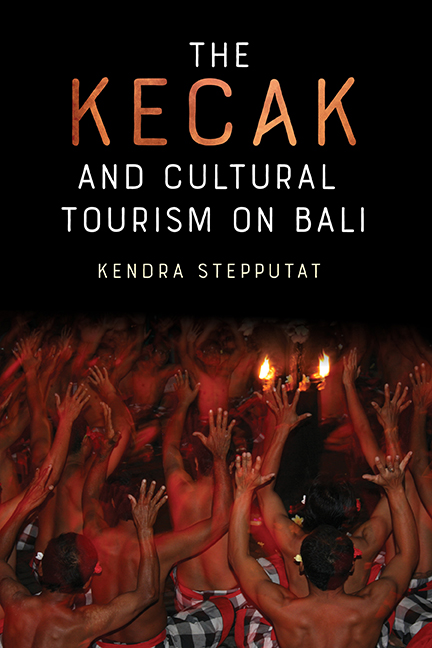Book contents
- Frontmatter
- Contents
- Acknowledgments
- Note to the Reader
- Introduction
- Part 1 The Present
- Part 2 The History
- Appendix 1 Kecak dan Wisata Budaya di Bali (Indonesian Summary)
- Appendix 2 Kecak Groups of Bali in 2000–2001 (Badung and Gianyar)
- Appendix 3 Facsimile of a Letter from Walter Spies to Leo Spies, 1932
- Glossary
- Bibliography
- Index
7 - The First Kecak
Published online by Cambridge University Press: 07 October 2022
- Frontmatter
- Contents
- Acknowledgments
- Note to the Reader
- Introduction
- Part 1 The Present
- Part 2 The History
- Appendix 1 Kecak dan Wisata Budaya di Bali (Indonesian Summary)
- Appendix 2 Kecak Groups of Bali in 2000–2001 (Badung and Gianyar)
- Appendix 3 Facsimile of a Letter from Walter Spies to Leo Spies, 1932
- Glossary
- Bibliography
- Index
Summary
I will now show how from the 1920s to 1930s the kecak developed out of the sanghyang dedari to become one of the most well-known dance performance genres for tourists on Bali. I trace this development in terms of musical structure, movement structures, and stage setting by focusing on several prominent historical sources that give snapshots of its progress over time. In the reconstruction of the influences as well as the actual outcomes of the transition from sanghyang to kecak, my focus is on the people and places involved as well as the overall social and political background of early twentieth-century Bali.
1931: Kecak in Insel der Damonen?
The chapter on the sanghyang dedari in performance describes how the film Insel der Dämonen made on Bali in 1931 features a ritual sanghyang dedari, albeit in a rearranged form made suitable for the film and a Euro-American audience. Why is it then that so many authors declare that the sanghyang dedari in Insel der Dämonen is a kecak? Rhodius and Darling, for example, write, “This [Insel der Dämonen] was the occasion for which Spies remodeled the kecak, the so-called monkey-dance. He increased the number of participants to more than a hundred young men sitting in a circle, and also introduced the figure of the dancer-narrator who recites, in the light of a central standing lamp, tales from the Ramayana involving the exploits of Hanoman, the monkey-general.”
Picard expresses it similarly, stating that “when in 1931 Baron von Plessen asked Spies to be his advisor for the shooting of his film Insel der Damonen, filmed in Bedulu, Spies modified the Kecak by enlarging the group to some 50 men seated in concentric circles for a more dramatic staging.” Dibia agrees: “In 1932, Spies was consultant for a German film company producing a movie in Bali called ‘Die Insel der Dämonen’ or The Island of Demons. This new form was designed so that it would be both brief and visually exciting for the film. Spies did this by suggesting the Balinese take the chorus of the Sanghyang and add scenes from the popular Ramayana epic.”
My best guess is that these authors did not have access to the film itself and relied on secondary sources only. The film neither includes scenes from the Ramayana, nor is the group enlarged to fifty or even a hundred men, and there is certainly no dance-narrator.
- Type
- Chapter
- Information
- The Kecak and Cultural Tourism on Bali , pp. 237 - 285Publisher: Boydell & BrewerPrint publication year: 2021



